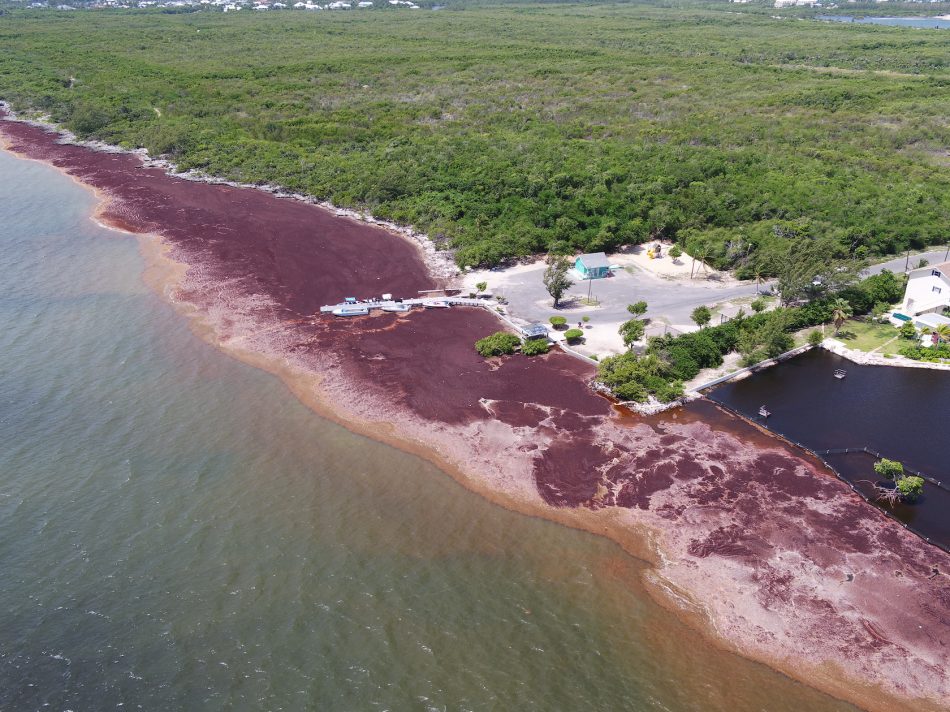Cayman Government monitoring Sargassum blooms

The Cayman Islands Government is monitoring the Great Atlantic Sargassum Belt – a patch of seaweed stretching more than 5,000 miles and estimated to weigh more than 10 million tonnes – which is currently drifting through the Caribbean Sea towards the Gulf of Mexico.
The Department of Environment (DoE) and Cayman Islands National Weather Service (CINWS) have access to regional Sargassum forecasting and tracking systems, including NOAA’s predictive Sargassum model. Nevertheless, it remains difficult to predict local stranding events before they occur. A combination of interrelated factors, including prevailing winds and complicated nearshore currents, contribute to whether floating Sargassum lands on local shores.
Ministry of Sustainability & Climate Resiliency Chief Officer Jennifer Ahearn says the high levels of Sargassum in the Caribbean Sea this year increase the likelihood of the Cayman Islands being impacted in 2023.
“The Cayman Islands is one of many countries increasingly impacted by large Sargassum blooms over the past decade. These influxes of Sargassum are driven by external factors such as climate change and increases in nutrients from terrestrial deforestation and represent an emerging, long-term issue that governments, scientists and private sector organisations across the Caribbean region are all working to address. At this time, there is no ‘one size fits all’ solution to Sargassum. Each largescale beaching event is different and responses – whether led by the public or private sector – will need to take these unique circumstances into account to ensure our interventions do not cause unintentional, negative impacts on local habitats and species,” she said.
Sargassum is a natural part of the ocean ecosystem and healthy patches of this floating seaweed can serve as important habitats for fish, crabs, shrimp, turtles and birds. In smaller quantities, Sargassum that washes up on shore is naturally washed away or buried by wave action, nourishing the beach and stabilising the shoreline.
A task force was previously established under the Ministry of Planning, Agriculture, Housing and Infrastructure to tackle largescale Sargassum influxes affecting public beaches and boat ramps. The Ministry of Sustainability & Climate Resiliency, working in collaboration with the DoE, Cayman Islands National Weather Service, Hazard Management Cayman Islands among other agencies, is producing a holistic framework to quickly coordinate a national response in the event of Sargassum stranding incidents.
“The Government continues to actively monitor the Sargassum blooms and is prepared to act upon stranding incidents as we have in the past, whether through clean-ups of public beaches and boat ramps led by the Public Works Department or using new techniques like we did in response to the North Sound stranding event last year. The national response framework will serve to formalise existing roles and responsibilities, and clarify thresholds for mobilising certain agencies,” Ahearn said.
Last year, in response to an unusual stranding event which affected the North Sound in Grand Cayman, the Cayman Islands Government trialed an initiative to pump the Sargassum out of the water and transport the seaweed to the George Town Landfill. The trial removed more than 2,880 square feet of seaweed before it became too degraded, and the teams on the ground learned a lot about the parameters for success using this method. Whether this methodology is used again will depend on the unique circumstances of the incident, and the potential impacts on the Cayman Islands natural environment, communities and tourism product.
The DoE has developed informational materials and a seaweed removal enquiry form to help landowners determine when action is needed to address stranded Sargassum and when it is best to let nature take its course. Special precautions should also be taken during turtle nesting season. These materials may be accessed on the DoE website: https://doe.ky/sustainable-development/best-practices-guides/sargassum-removal/
In larger quantities, Sargassum strandings can reduce water oxygen levels and light penetration with the potential to negatively affect marine life, and cause a nuisance to residents and visitors. Although smelly, Chief Medical Officer Dr. Nick Gent says Sargassum does not represent a significant risk to human health.
“When Sargassum mats become stranded on the shoreline they will decompose. Like all decomposing biomass, it will produce gasses, such as hydrogen sulfide, which can have an unpleasant smell, even producing feelings of nausea. However, being outdoors, such gasses usually disperse rapidly and do not cause injury or illness,” he said.
In unusual circumstances where these gasses may not disperse quickly, low residual concentrations of hydrogen sulfide may can cause irritation to the eyes, nose, and throat. As degrading Sargassum may contain a complex mix of irritants, direct contact may cause skin rashes and it is recommended that people working to clear such materials use appropriate workwear and wash their hands after contact.
For more information on Sargassum, including how to remove Sargassum from local beaches and potential uses for Sargassum, please visit: https://doe.ky/sustainable-development/best-practices-guides/sargassum-removal/





